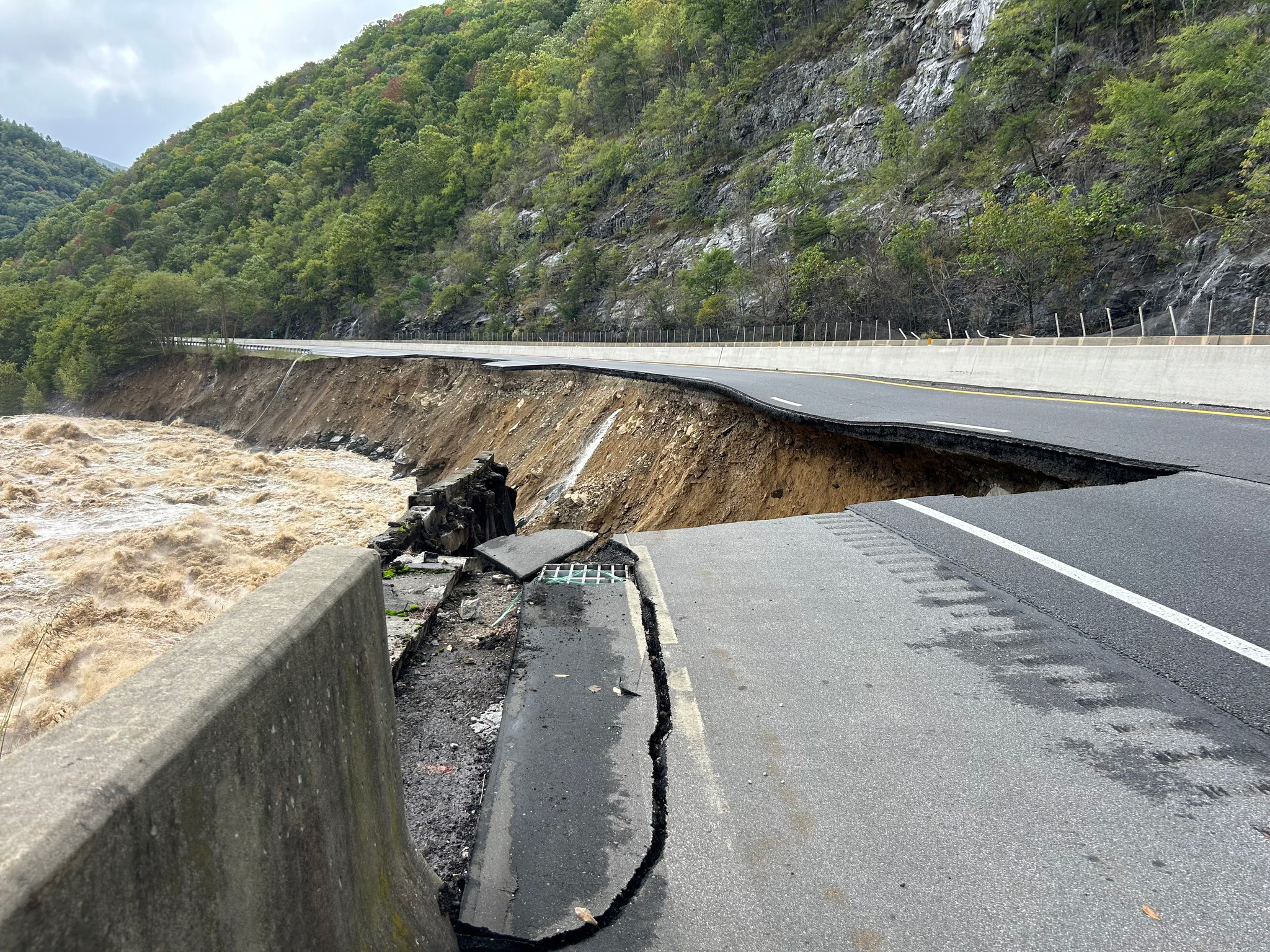
When the Safe Passage coalition started working in 2017 to make Interstate 40 a safer place for people and wildlife through the Pigeon River Gorge, nobody knew that, in a few short years, entire sections of the critical roadway would vanish in the wake of Hurricane Helene. The scale of Helene’s damage was unfathomable, with 101 people confirmed dead in North Carolina alone and some survivors still lacking basic necessities like shelter, electricity, and potable water. The region is in mourning—but the rebuilding process may offer a once-in-a-generation opportunity to save the lives of future travelers.
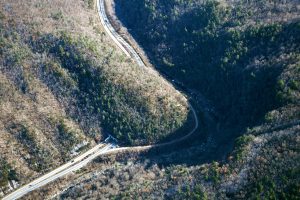
“If we want to look for silver linings, I think there is a chance that we could use this long pause in traffic on I-40 to create some win-wins for wildlife, driver safety, and flood resilience along the road,” said Ron Sutherland, chief scientist for coalition partner Wildlands Network.
The 28-mile stretch of I-40 that passes through the Pigeon River Gorge bisects a rugged landscape that falls mostly within the Pisgah National Forest, Cherokee National Forest, and Great Smoky Mountains National Park. It’s one of the most biodiverse places on the planet, and before Helene, the road handled about 26,500 vehicles every day—a formidable barrier to natural wildlife movement across the landscape. Between 2018 and 2020, researchers Liz Hillard of Wildlands Network and Steve Goodman of National Parks Conservation Association analyzed 304 collisions between vehicles and large animals like bear, deer, and elk. Nationwide, wildlife–vehicle collisions kill more than 200 people annually and cost over $10 billion, according to a 2023 report from the Federal Highway Administration.
Through collaboration with government agencies and efforts to secure funding for wildlife crossings, Safe Passage has been working toward infrastructure solutions that would prevent such crashes from happening. Thanks to the group’s partnership with the NC Department of Transportation, the designs for five I-40 bridges up for replacement were amended to include wildlife-friendly modifications, and the agency was poised to use a $2 million wildlife-crossing allotment from the NC General Assembly to install fencing and evaluate Wildlands Network’s and NPCA’s research-based proposals for improving connectivity in the gorge.
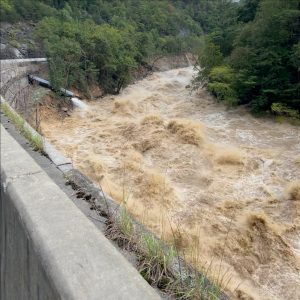
Then Helene struck.
The hurricane hit the Gulf Coast as a Category 4 storm and then moved north, dropping record-setting amounts of rain on communities across Southern Appalachia. A gauge on the Pigeon River just below the power plant at Waterville, located along the I-40 corridor, jumped from its normal level of four feet up to nearly 22 feet before the river tore the gauge out around 10 a.m. September 27, as the worst of the flooding unfolded. Three of the five bridge replacements were completed, or nearly so, when the hurricane arrived, and they came through mostly unscathed. However, other areas of the road incurred catastrophic damage. Eastbound lanes in the four-mile stretch between the Tennessee–North Carolina state line and North Carolina mile marker 4, where both east- and westbound lanes of traffic disappear into a tunnel, bore the brunt of the destruction. In some places, the shoulder is gone. In others, one lane crumbled, and in some, both lanes are missing. The road saw significant damage on the Tennessee side of the state line too, with the eastbound lanes damaged in multiple locations from mile 446 to the state line at mile 451.
“Because of the alignment of the river versus the road coming in from an angle, the water got in behind walls,” explained Wanda Payne, Division 14 engineer for NCDOT. “And so once it got behind those walls, it just ate out the dirt. It’s like ‘between a rock and a hard place,’ except our hard place wasn’t as hard as we thought it was, so the rock won.”
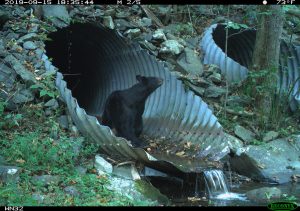
The highway between Maggie Valley and the state line has been closed since the storm as NCDOT develops plans for both emergency stabilization and long-term repair, while the adjoining five miles in Tennessee are open only as a two-lane road for local, noncommercial traffic. Across North Carolina, about 300 road closures remained in place, and roughly 8,000 sites were damaged as of Nov. 4. Among them are at least 140 bridges in need of replacement.
“I definitely sympathize with the DOT, because they’re in a position where they feel like they need to be racing ahead to get all these things put back in place, but at the same time, I hope that the public can see the opportunity here,” said Sutherland. “We can make it so that the next time a big storm like Helene comes through, our infrastructure actually survives.”
For this, Sutherland sees Vermont as a role model. Hurricane Irene inflicted massive damage on the state in 2011, and afterward Vermont invested nearly $230 million in 130 infrastructure projects designed to withstand similar weather events in the future. The state saw another round of major flooding in 2023, and those sites were either undamaged or minimally impacted.
Any bridge or culvert that can survive a storm like Helene will need to be “absurdly big and strong,” Sutherland said, ensuring space to install culverts or underpasses large enough for bear, deer, and other animals. Wildlands Network recently completed an analysis of North Carolina bridges damaged by Helene that prioritizes their importance for wildlife connectivity.

“If we’re able to put in better bridges that are more floodproof and stronger and bigger on even a quarter or half of those sites,” Sutherland said, “that’s going to have huge benefits for wildlife.”
But it’s a time-sensitive issue. The DOT is working to restore the state’s transportation infrastructure as quickly as possible, an undertaking expected to be extremely expensive, even without considering wildlife crossings. The Safe Passage group is working hard to offer planners its input and help secure funding for installations that could benefit wildlife for generations to come.
“If we miss this opportunity, then Hurricane Helene could have the counterintuitive result of foreclosing on the likelihood for wildlife improvements at hundreds of sites over the next 50 years,” Sutherland said. “Who will want to tear out shiny new bridges and culverts?”

NCDOT structures destroyed by Helene had an average age of 60, meaning that many of them would have been up for replacement in the coming years. Losing the opportunity to improve their utility for wildlife post-Helene would be a “serious setback,” Sutherland said.
The Pigeon River Gorge continues to be a top priority for Safe Passage. The area damaged by Helene includes four sites in Tennessee and three in North Carolina that the research from Wildlands Network and NPCA flagged for wildlife-crossing concerns. In any highway project, rerouting traffic comprises a significant percentage of the budget—but if wildlife-crossing structures could be dropped in while the road is still closed, these improvements could be made with less hassle or expense than will likely be possible again anytime soon.
Safe Passage’s earlier efforts to coordinate with transportation planners have paved the way to make such an outcome more likely than it would have been prior to the group’s formation—Payne said that NCDOT’s plans will address wildlife concerns mentioned in the report. But what that repair might look like is still an open question. In many places, the entire bedrock on which the road rested is gone. NCDOT may decide against rebuilding I-40 exactly as it was before.
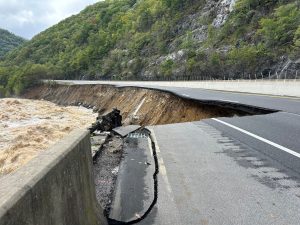
Due to potential difficulty in securing reimbursement from the Federal Highway Administration, it’s unlikely NDOT will choose to reroute the entire corridor. However, realignment within the most-affected area is a possibility, as are walls, viaducts, and bridges. The NCDOT awarded Wright Brothers Construction an $8.5 million contract to perform temporary emergency repairs on the road and expects to open the westbound lanes for two-way traffic by New Year’s Day. Tennessee has not yet announced a timeline for permanent repair of its portion of the road, but NCDOT expects to complete that task by October 2026. It has hired Ames Construction as contractor, RK&K as designer, and HNTB as project manager. Payne wants all three parties to meet with Safe Passage early in the process to discuss how wildlife crossings should factor into the design.
“If we’re going to go to the trouble of replacing all these bridges and culverts and highways, why not do it in a way that’s going to survive the next flood, because we certainly don’t know when that’s going to be,” Sutherland said. “If we build back with flood resilience in mind, we’ll also promote wildlife connectivity for species people care about.”
Subscribe to get the latest posts sent to your email.
The Great Smokies Welcome Center is located on U.S. 321 in Townsend, TN, 2 miles from the west entrance to Great Smoky Mountains National Park. Visitors can get information about things to see and do in and around the national park and shop from a wide selection of books, gifts, and other Smokies merchandise. Daily, weekly, and annual parking tags for the national park are also available.